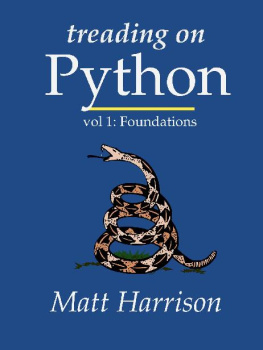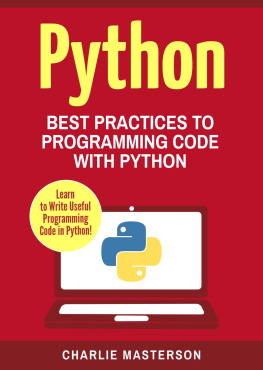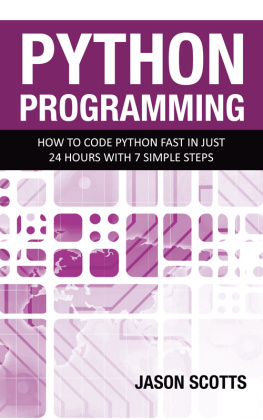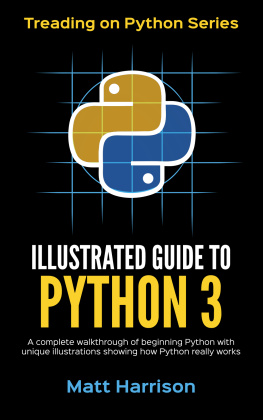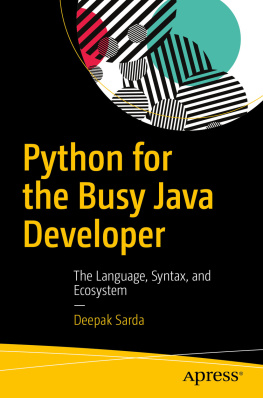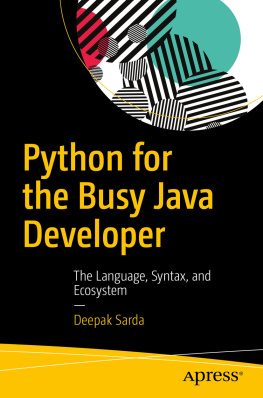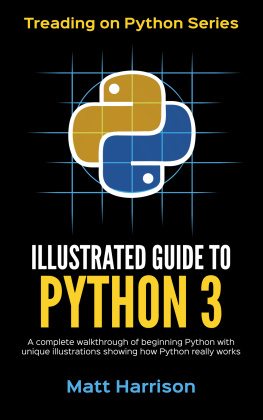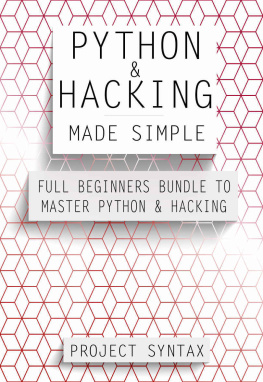Harrison - Treading on Python Volume 1: Foundations of Python
Here you can read online Harrison - Treading on Python Volume 1: Foundations of Python full text of the book (entire story) in english for free. Download pdf and epub, get meaning, cover and reviews about this ebook. year: 2011, genre: Computer. Description of the work, (preface) as well as reviews are available. Best literature library LitArk.com created for fans of good reading and offers a wide selection of genres:
Romance novel
Science fiction
Adventure
Detective
Science
History
Home and family
Prose
Art
Politics
Computer
Non-fiction
Religion
Business
Children
Humor
Choose a favorite category and find really read worthwhile books. Enjoy immersion in the world of imagination, feel the emotions of the characters or learn something new for yourself, make an fascinating discovery.
Treading on Python Volume 1: Foundations of Python: summary, description and annotation
We offer to read an annotation, description, summary or preface (depends on what the author of the book "Treading on Python Volume 1: Foundations of Python" wrote himself). If you haven't found the necessary information about the book — write in the comments, we will try to find it.
Treading on Python Volume 1: Foundations of Python — read online for free the complete book (whole text) full work
Below is the text of the book, divided by pages. System saving the place of the last page read, allows you to conveniently read the book "Treading on Python Volume 1: Foundations of Python" online for free, without having to search again every time where you left off. Put a bookmark, and you can go to the page where you finished reading at any time.
Font size:
Interval:
Bookmark:
Technical Editor: Shannon -jj Behrens
Copyright 2011
While every precaution has been taken in the preparation of this book, the publisher and author assumes no responsibility for errors or omissions, or for damages resulting from the use of the information contained herein.
Are you ready to jumpstart your Python programming career? This book will arm you with years of knowledge and experience are condensed into a easy to follow format. Rather than taking months reading blogs and websites and searching mailing lists and groups, this book will allow a programmer to quickly feel knowledgable and comfortable with Python.
Programming is fun and Python makes it delightful. Basic Python is not only easy, but approachable for all ages. I have taught elementary students, teenagers, industry professionals and golden years folks the Python programming language. If you are willing to read and type, you are about to begin an exciting path. Where it ultimately takes you depends on how hard you are willing to work.
There are a different levels of Python. Basic Python syntax is small and easy to learn. Once you master basic Python, doors will open to you. You should be able to read a lot of Python and understand it. From there, you can learn more advanced topics and specific toolkits, start contributing to open source projects written in Python, or use that knowledge to learn other programming languages.
A recommended approach for learning the language is to read a chapter then actually sit down at a computer and type out some of the examples found in the chapter. Python makes it easy to get started, eliminating much of the rain dancing found in running programs in other languages. The temptation will likely be to merely read the book. By jumping in and actually typing the examples you will learn a lot more than just reading.
There are many programming languages and the popularity of them ebb and flow. Java seems to be the most common language in industry today, and even powers the Android mobile devices. Though if you want to play in Steve Jobs' world, Objective C is the language dejour. Python is a great language to dabble in before learning either of these. It requires less typing and is dead simple to get started in. Though you might decide these other languages are less appealing after learning Python.
Python enables productivity. I came to Python as a Perl programmer. At work I was tasked to work with a co-worker who was well versed in Tcl. Neither wanted to jump ship and both of us were interested in learning Python. In 3 days our prototype was completed, much faster than we expected, and we both promptly forgot our previous language. What appealed to me about Python was that it fit my brain. I firmly believe if you have some experienced in programming you can learn the basics of Python in a few days.
Python is easy to learn. For beginning programmers, Python is a great place to start. Learning to write simple programs is pretty easy, yet Python also scales up to complex enterprise systems. Python also scales with age, I have personally seen people from 7-80+ learn basic programming skills using Python.
Python is in demand. Python is also widely used and pretty popular, especially among smaller startups. Back when I learned Python, we needed to hide that we were using it. Luckily those days are far behind us. Python is now found all over the wild workplaces of today, and is one of the most common languages found in startups.
This book will focus on Python 2. Python 3, has been out for a bit now and is somewhat backwards incompatible with the 2 series. Why use Python 2 then? Frankly for beginning Python, there are few differences. The current advantage of Python 2 is that third party library support is better. All of the major libraries for Python are satisfied with version 2 and some do not feel much pressure to migrate to version 3.
For the most part, the examples in this book will run on both Python 2 and 3, but it was written and tested with Python 2 in mind. Which version of Python 2 does the book focus on? The examples were tested in 2.6 and 2.7 but should work in 2.4 and above.
Python 2 is installed on many non-Windows platforms. If you are running on Mac or Linux you can skip the next paragraph.
For Windows folks, go to http://www.python.org/download and find a link that says Python 2.7.2 Windows Installer (2.7.2 was the most recent 2.7 version at the time of writing). This will link to a .msi file that will install python on your Windows machine. Download the file, and open it by double clicking it, and follow the instructions to finish the installation.
An editor is a tool for writing code. A skilled craftsman will learn to use their tool appropriately and it will pay dividends. Learning to use the features of an editor can make churning out code easier. Many modern editors today have some semblance of support for Python. Note that Notepad and word processors are not really text editors, though they might act as such on Halloween. For Windows users, Notepad++ and the latest version of Visual Studio have Python support. For Mac people, TextMate appears to be a popular choice. Kate, and gedit appear to be sensible Linux choices.
If you are just beginning with Python and have not had much experience with real text editors, many Python installations include IDLE, which has decent Python editing features. The IDLE development environment also runs on Windows, Mac and Linux.
Many programmers favor Vim or Emacs. For Java people, both Eclipse (via PyDev) and JetBrains (via PyCharm) provide Python support. Wing is another cross platform Python specific editor that many favor. Komodo is another that some people prefer. There are many other editors available, though one advantage of those mentioned in this paragraph is that they are cross platform if you find yourself working in different environments. As you can tell there are many editors, and each has their advantages and disadvantages. If you do not have a favorite editing tool, it is probably best to use a simple one such as Notepad++, TextMate or gedit. Editors such as Vim and Emacs have a slightly steeper learning curve.
Python is commonly classified as an interpreted language. Another term used to describe an interpreted language is scripting language. In order to get computer programs to run on the CPU, the program must be in a format that the CPU understands, called machine code. Interpreted languages do not compile directly to machine code, instead there is a layer above, an interpreter that performs this function.
There are pros and cons to this approach. As you can imagine, on the fly translating can be time consuming. This can cause Python programs to run on the order of 10100 times slower than a C program. On the flip side, Python programs can optimize for developer time. It is not uncommon for a Python program to be 210 times shorter than its C equivalent. Also, a compilation step can be time consuming and actually a distraction during development and debugging.
This is a trade-off that many developers are willing to accept. Smaller programs take less time to write and are easier to debug. Programmers can be expensive if you can just throw hardware at a problem it can be cheaper than hiring more programmers. Debugging 10 lines of code is normally easier than debugging 100 lines of code. Studies have shown that the number of bugs in code is proportional to the numbers of lines of code. Hence, if a language permits you to write fewer lines of code to achieve a given task, you will likely have fewer bugs. Sometimes program execution speed is not that important and Python is sufficiently fast for many applications. In addition there are efforts to improve the speed of Python such as PyPy.
Font size:
Interval:
Bookmark:
Similar books «Treading on Python Volume 1: Foundations of Python»
Look at similar books to Treading on Python Volume 1: Foundations of Python. We have selected literature similar in name and meaning in the hope of providing readers with more options to find new, interesting, not yet read works.
Discussion, reviews of the book Treading on Python Volume 1: Foundations of Python and just readers' own opinions. Leave your comments, write what you think about the work, its meaning or the main characters. Specify what exactly you liked and what you didn't like, and why you think so.

